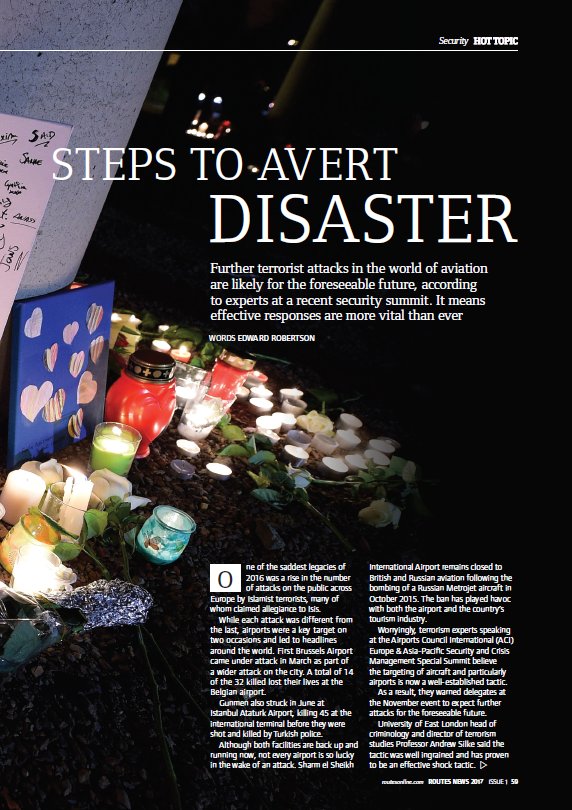One of the saddest legacies of 2016 was a rise in the number of attacks on the public across Europe by Islamist terrorists, many of whom claimed allegiance to Isis. While each attack was different from the last, airports were a key target on two occasions and led to headlines around the world.
First Brussels Airport came under attack in March as part of a wider attack on the city. A total of 14 of the 32 killed lost their lives at the Belgian airport. Gunmen also struck in June at Istanbul Ataturk Airport, killing 45 at the international terminal before they were shot and killed by Turkish police.
Although both facilities are back up and running now, not every airport is so lucky in the wake of an attack. Sharm el Sheikh International Airport remains closed to British and Russian aviation following the bombing of a Russian Metrojet aircraft in October 2015. The ban has played havoc with both the airport and the country’s tourism industry.
Worryingly, terrorism experts speaking at the Airports Council International (ACI) Europe & Asia-Pacific Security and Crisis Management Special Summit believe the targeting of aircraft and particularly airports is now a well-established tactic. As a result, they warned delegates at the November event to expect further attacks for the foreseeable future.
University of East London head of criminology and director of terrorism studies Professor Andrew Silke said the tactic was well ingrained and has proven to be an effective shock tactic. He believes that with Isis continuing to fight in Syria and Iraq while extending its influence across Europe, the continent should brace itself for further attacks. Silke said: “Is the threat real? It obviously is. Terrorists have attacked airports and airliners over the past 50 years. Their goals might change and the violence might change, but the threat to airports is there.”
His comments were backed up by former EU counter-terrorism coordinator and senior visiting fellow at the London School of Economics Gijs de Vries. He said attacks had been on the rise in the past few years with 38 people killed in Europe in terrorist attacks between 2009 and 2013.
By comparison, he said 151 were killed by terrorists in 2015, while in 2016 more than 61 people were killed in the airport attacks alone. Other atrocities such as the Nice attack in July killed 84 members of the public. De Vries added that Europol had also foiled a further 211 attacks this year, with more than 1,000 arrests made in connection with them. He believes the danger of further attacks remains very real in Europe as Isis fighters return from the Middle East in order to inspire the next generation of terrorists.
De Vries said the fight against terrorism is further compounded by the absence of any Europe-wide equivalent of the FBI or CIA to tackle the problem and failure of individual European police forces to share intelligence. However, he argued that it was vital to continue fighting the problem in order to secure Europe’s safety now and in the future. He added: “Successful counter terrorism is about more than law enforcement. We must not only stop today’s terrorists but stop the next generation from being radicalised.”
Belgian deputy prime minister and minister of the interior and security Jan Jambon also used the event to argue that there are a number of measures to help protect airports. He said effective information gathering and sharing among European security teams was vital to pre-empt attacks while airports should consider various tactics to better protect themselves, ranging from improved car number-plate reading technology being employed further from the airport to more behaviour detection officers patrolling terminals looking for suspicious behaviour.
Jambon added: “The huge thing to do in terms of security is to anticipate rather than react. Once you have to react, it is already too late. The Bataclan attack (in 2015 in Paris) sent the message that we are all targets now – no matter who you are, we will hit you with random acts of violence.”
Delegates at the event were also broadly welcoming of the UN Security Council Resolution 2309, which seeks to improve civil aviation safety. The resolution not only backs enhanced security and screening but is also urging states to share intelligence more for the benefit of all.
Stepping up the pace of change Alexis Long, Heathrow’s head of security policy and a member of the ACI Europe aviation security committee and ACI world security standing committee, was just one of the delegates to back the resolution. However, he urged conference delegates to pick up the rate of change to make flying safer quicker. Long said: “The UN security resolution is very good, but is it going to deliver the rate of change quickly enough? “Plots are happening right now and we are not reacting quickly enough.”
He also argued that while legislation is light on how airports can protect themselves, the industry should use it as an opportunity to set its own standards with less outside interference. Long added: “What I would like is if we could get together and explore that and come up with a situation that suits us, and take the pressure off the politicians from having to do more.”
He used the event to urge other airport operators to start implementing improvements to their security as opposed to simply discussing them. “While I absolutely get that it is a very important topic to discuss and we need to be clear on improving it, my fear is we’re talking about it too much,” Long said.
The attack on Brussels Airport in March last year represented the changing nature of the threat to the aviation industry. Speaking at the ACI Europe and Asia-Pacific security and crisis management special summit in Brussels, Arnaud Feist, Brussels Airport CEO and ACI Europe immediate past president, said terrorists are evolving their tactics all the time.
He said that while getting airside and hijacking aircraft had got harder for terrorists, thanks to improved security, they had simply found new places to target. Feist added: “The threat, which was mainly airside in the past, is changing. It is clearly moving over to the landside area, which is an open public space. It is no different from a train station or a supermarket.”
He said this meant more must be done to pre-empt attacks in the first place and urged governments to focus even more on gathering intelligence to stop an attack at the planning stages. Feist added: “We have to catch those terrorists before they ever think of going to the airport. Once they arrive at the airport, it is generally over and all you can do is limit the damage.”
This is not to say an airport can do nothing to protect itself. Brussels Airport staff are currently taking a number of measures in the wake of the attack on March 22, 2016. A total of 32 people were killed as three suicide bombers attacked first the airport, where 14 were killed, then the capital’s underground system.
He said the number of cameras, which are equipped with facial recognition technology, had increased from 1,000 to 1,250 while blast reduction glass could minimise the damage should there be more explosions. Feist questioned whether a remote bag drop could be introduced while the airport’s 20,000 staff had also been urged to remain vigilant for any warning signs.
A joint control room has also had the benefit of ensuring that staff from differing agencies now sit together and can better deal with an emergency as a result. However, Feist admitted that improved security is part of a balancing act as the airport must still be able to handle efficiently its 23 million passengers each year.
He added: “In conclusion, I would say obviously it will never be the same. The good news is we are back stronger than ever. We launched our 25-year strategic plan last week and security is part of that plan. Zero risk doesn’t exist and I think we are all aware of that, but security is our top priority. What we are all striving for is to give all of our passengers all of the time a safer experience.”
The fact that Feist and his staff are feeling so positive about the future shows just how much hard work has been done by staff since March. Feist said the key priority was the safety of the public and there were more than 5,000 people requiring assistance on the day. This was just one logistical issue to deal with, though – the airport also had 10,000 bags left behind, while anyone who had driven to the airport was forced to go home without their cars.
Despite these changes, and the damage done by the bombers, which had seen the departure hall severely damaged, Feist said they were able to get the airport back working on 100 per cent capacity within 72 days. Passengers initially had to check in at a marquee, where they all underwent safety checks. There was also a checkpoint for all cars arriving at the airport.
However, Feist added that the new measures simply created targets elsewhere, so in May the airport partially reopened the departure hall before its full return was completed in June with 144 check-in desks up and running. Full scanning of 100% of the passengers was also scaled back and now three cabins at the entrance to the departures hall are used by police trained in behavioural checks to monitor suspicious-looking passengers.
Feist said that some staff were still recovering from the trauma with psychiatric help but added that a return to normality was the best way of beating the terrorists. He commented: “In the end, what terrorists want to achieve is chaos, creating fear and slowing down the normal activity of the people in Europe.”
The boss of TAV Istanbul Ataturk Airport is a great believer that the best way to beat the terrorists is to get on with life as quickly as possible. CEO Sani Sener said the facility reopened just eight hours after the attack on June 28, 2015, which saw 45 people killed after three terrorists attacked with automatic rifles and explosive belts. He added: “When you reopen, you have a message to the terrorist – you are saying you cannot interfere in our daily lives.”
However, Sener said the attack could have been a lot worse if it hadn’t been for the police, even though they initially thought the terrorists were baggage thieves. Instead, they only realised the full extent of the danger once the attackers pulled out their guns and started shooting.
He added: “[The attackers] tried to get to the [Turkish Airlines] CIP lounge in the international terminal which could have had as
many as 500 or 600 passengers there. They were trying to kill the business class passengers. If they had detonated themselves in the CIP lounge, then they could have had the chance to kill 500 people. The secret in crisis management… is preventing the bad from
getting worse.”
Now, Sener believes there needs to be greater cooperation between the public and private partnerships, thus allowing for the better sharing of intelligence. He also said the airport had learnt the importance of having effective muster points for evacuating passengers. They also encountered a number of additional problems with transit passengers who were evacuated but didn’t have the correct visas. Staff are also receiving help to get over the attack he said, adding: “We give them time, we give them love. It was a traumatic situation.”
 |
This article is modified from an original feature that appeared in... ROUTES NEWS - ISSUE 1, 2017 PLEASE CLICK HERE to view the magazine. |
 |





